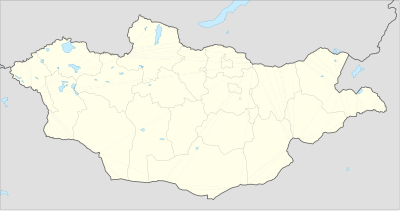This list includes cities in Mongolia of more than 7,500 inhabitants. The results are from the census of January 5, 2000 as well as from a population estimation for the end of 2008. If 2008 year data was not accessible, the closest and most reliable data was used and noted by an index.
The population for previous years show the historical significance of population growth and urbanisation throughout Mongolia.
Population data
editThe higher level administrative unit is the aimag, except for Ulaanbaatar which administers its own federal district (Nalaikh and Baganuur are administered by Ulaanbaatar). The numbers of inhabitants relate to the cities proper without surrounding districts.
| Rank | Name | 1979 est.[1][2][3] | 1989 est.[4][5] | 2000 census[6][7] | 2010 Census[8] | Change since 2000 Census | Province/Municipality |
|---|---|---|---|---|---|---|---|
| 1 | Ulaanbaatar [a] | 396,300 | 540,600 | 760,077 | 1,144,954 | 299,715[9] | Ulaanbaatar |
| 2 | Erdenet | 29,100 | - | 70,950 | 83,379 | 12,429 | Orkhon Province |
| 3 | Darkhan | 49,100 | - | 65,791 | 74,738 | 8,947 | Darkhan-Uul Province |
| 4 | Choibalsan | 28,500 | 37,300 | 40,123 | 38,537 | 1,586 | Dornod Province |
| 5 | Mörön | 16,500 | 21,300 | 28,903 | 35,789 | 6,886 | Khövsgöl Province |
| 6 | Nalaikh | - | - | 23,600 | 30,049 | 6,449 | Ulaanbaatar |
| 7 | Bayankhongor | 16,300 | 21,200 | 22,066 | 29,817 | 7,751 | Bayankhongor Province |
| 8 | Ölgii | 18,700 | 27,200 | 25,791 | 29,392 | 3,601 | Bayan-Ölgii Province |
| 9 | Khovd | 17,500 | 24,100 | 25,765 | 29,012 | 3,247 | Khovd Province |
| 10 | Arvaikheer | 12,300 | 16,900 | 19,058 | 27,162 | 8,104 | Övörkhangai Province |
| 11 | Ulaangom | 17,900 | 22,900 | 25,993 | 27,152 | 1,159 | Uvs Province |
| 12 | Baganuur | - | - | 21,100 | 22,210 | 1,110 | Ulaanbaatar |
| 14 | Sainshand | 11,100 | 10,300 | 18,290 | 20,515 | 2,225 | Dornogovi Province |
| 13 | Tsetserleg | 14,700 | 20,300 | 18,519 | 20,604 | 2,085 | Arkhangai Province |
| 15 | Sükhbaatar | 14,300 | 19,600 | 22,374 | 19,662 | 2,712 | Selenge Province |
| 16 | Öndörkhaan | 11,100 | 14,400 | 18,003 | 19,000 | 997 | Khentii Province |
| 17 | Dalanzadgad | 10,000 | 14,300 | 14,050 | 18,740 | 4,690 | Ömnögovi Province |
| 18 | Züünkharaa | 11,400 | - | 15,000(2004) | 18,002 | Selenge Province | |
| 19 | Uliastai | 15,400 | 20,300 | 18,154 | 17,468 | 686 | Zavkhan Province |
| 20 | Altai | 13,700 | 18,800 | 15,741 | 16,542 | 801 | Govi-Altai Province |
| 21 | Baruun-Urt | 11,600 | 16,100 | 15,133 | 16,130 | 997 | Sükhbaatar Province |
| 22 | Mandalgovi | 10,200 | 16,100 | 14,517 | 13,660 | 857 | Dundgovi Province |
| 23 | Zuunmod | 9,800 | 15,800 | 14,837 | 13,330 | 1,507 | Töv Province |
| 24 | Zamyn-Üüd | - | - | 5,486 | 13,285 | 7,799 | Dornogovi Province |
| 25 | Bulgan | 11,300 | 12,800 | 12,681 | 11,320 | 1,361 | Bulgan Province |
| 26 | Kharkhorin | - | - | 13,648 | 10,847 | 2,801 | Övörkhangai Province |
| 27 | Choir | 4,500 | - | 8,983 | 9,708 | 725 | Govisümber Province |
| 28 | Bor-Öndör | - | - | 6,406(2001) | 8,080 | Khentii Province | |
| 29 | Sharyngol | - | - | 8,902 | 7,795 | 1,107 | Darkhan-Uul Province |
Colour key:
- Salmon cells indicate that the population has declined or experienced minimal (<1%) growth.
- Light green cells indicate a growth between 1-2%.
- Dark green cells indicate a growth of greater than or equal to 2%.
Notes:
- ^ Includes Nalaikh, Baganuur and Bagakhangai
See also
editReferences
edit- ^ City Population - Historical population figures
- ^ Statistisches Bundesamt: Statistik des Auslands - Mongolei, 1985
- ^ Encyclopedia "Cartactual," published 01/01/85
- ^ City Population - Historical population figures
- ^ "NSO". Archived from the original on 2009-01-03. Retrieved 2009-01-03. National Statistical Office of Mongolia (accessed May 2, 2007)
- ^ City Population - Historical population figures
- ^ (2000) PADCO: Mongolia Urban Development and Housing Sector Strategy, Final Report, Vol. 2, published 2005.
- ^ "Mongolia extended population statistics". GeoHive. 2015. Archived from the original on 15 November 2015.
- ^ "Mongolian National Statistical Information Service". 1212.mn. 2018.
